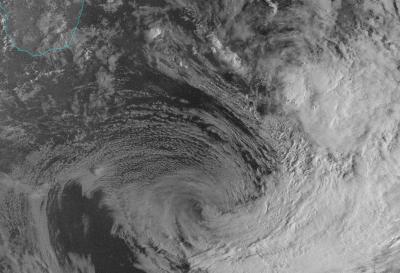NASA-NOAA's Suomi National Polar-orbiting Partnership (Suomi NPP) satellite captured a night-time image of extra-tropical cyclone Felleng as it was being battered by wind shear in the Southern Indian Ocean.
The night-time satellite image was captured by the Visible Infrared Imager Radiometer Suite (VIIRS) aboard NASA-NOAA's Suomi NPP satellite on Feb. 3 at 2120 UTC (11:20 p.m. local time, Indian/Antananarivo/1:40 p.m. EST, U.S.) when Felleng was located south of the Mozambique Channel. The VIIRS image was created at the University of Wisconsin-Madison and showed that the bulk of Felleng's clouds and precipitation were pushed east and southeast of the center of circulation as a result of northwesterly vertical wind shear.
On Monday, Feb. 4 at 0600 UTC (1 a.m. EST) the Joint Typhoon Warning Center noted that Felleng completed its extra-tropical transition, and the storm's maximum sustained winds were near 40 knots (46 mph/74 kph). Felleng's center had moved to 31.1 south and 52.8 east, about 605 nautical miles (696.2 miles/1,120 km) south-southwest of La Reunion Island. Felleng continued to move south-southeast in the open waters of the Southern Indian Ocean where it is expected to dissipate in the next couple of days.

The night-time satellite image was captured by NASA-NOAA's Suomi NPP satellite on Feb. 3 at 11:20 p.m. local time, Indian/Antananarivo ) when extra-tropical cyclone Felleng was located south of the Mozambique Channel. The bulk of clouds and showers were pushed east and southeast from wind shear.
(Photo Credit: : NASA/NOAA/UWM, William Straka III)
The Suomi NPP mission is a bridge between NOAA and NASA legacy Earth observing missions and NOAA's next-generation JPSS. Suomi NPP flies for the first time the groundbreaking new Earth observing instruments that JPSS will use operationally. The first satellite in the JPSS series, JPSS-1, is targeted for launch in 2017. For more information on Suomi NPP, visit: www.nasa.gov/NPP.
Source: NASA/Goddard Space Flight Center